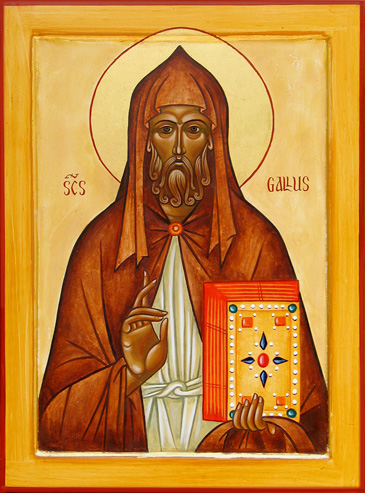Saint Gall
16 Οκτωβρίου 2011
SAINT GALL – Gallus (or Gall) was born in the year 550, just eight years before Saint Comgall founded his famous monastery at Bangor. Little is known of the boyhood of Gall except that it is generally thought that he showed great piety and interest in the Christian faith. As a young man he went to study under Comgall of Bangor. And here it should be noted that the monastery at Bangor (image of ruins, below) had become renowned throughout Europe as a great centre of Christian learning. Because of the great learning at Bangor, Ireland became known as “the land of Saints and Scholars”. Missionaries went out from Bangor Abbey to all parts of Ireland, the British Isles, and the Continent.
Studying in Bangor at the same time as Gall was Columbanus, to whose honour the parish church in Ballyholme on the other side of Bangor is dedicated. We might say that Columbanus had become a sort of right hand man of Saint Comgall, and that he felt a great call to missionary adventure. And so he laid before the Abbott Comgall his request to be set free for this work.
Comgall was loath to part with one who had become so great a help and comfort to him; but realising that he had no right to consider only his own convenience, he gave his consent, and Columbanus together with twelve companions, the most noted of whom was probably Gall, set out about the year 589, bidding a life-long farewell to home and friends in order to face unknown difficulties and dangers in the extension of God’s Kingdom on the Continent.
Columbanus, Gall and their companions settled for a while in Switzerland at Lake Constance. After a while Columbanus felt an urge to go into Italy, but Gall was taken sick of a fever, and couldn’t go with him, apart from the fact that he was more anxious for a life of solitude.
Recovering from his illness, Gall fixed upon a quiet place on the River Steinach for his life of solitude. Having begun with a three day fast there, he erected a small stone hut or cell for prayer, an oratory after the manner usual in Ireland. And so began the abbey (below) and the town of Saint Gall. Cells were soon added for twelve monks whom Gall carefully instructed.
Saint Gall was soon known in Switzerland as a powerful preacher. He is said to have thrown down images to heathen gods, and exhorted the worshippers of these images to return to the true God. As a result of Gall’s work, practically the whole of Switzerland is thought to have embraced the Christian faith.
When the See of Constance became vacant, the clergy who assembled to elect a new Bishop were unanimously in favour of Saint Gall on account of his superior learning and sanctity. He, however, refused, pleading that the election of a stranger would be contrary to Church law, but proposed his deacon John, who was duly elected and consecrated Bishop.
Some time later, in the year 625, on the death of Eustasius, who was abbott of Luxeuil, a monastery founded by Saint Columbanus, six members of that community, all Irishmen, were sent by the monks to request Saint Gall to undertake the government of the monastery. He definitely refused to quit his life of solitude, and undertake any office of rank which might involve him in the cares of the world. He was then an old man, and probably felt himself unable to cope with the duties of high office.
The Legend of Saint Gall
A legend about Saint Gall in his solitary life has become well known. The story tells how a bear became St. Gall’s sole friend in the closing years of his life, and that the bear used to carry logs to the saint so that he could light his fire. The bear has now become the coat of arms (below, on coin) for the town of St. Gallen in Switzerland, and the bear carrying the logs is depicted on the wall of the great Cathedral there, as it is in the parish church at Carnalea .
Saint Gall died on 16th October in the year 645, at the age of 95, and that date – 16th October – is now honoured in Carnalea parish each year as Saint Gall’s Day.
An assiduous preacher of the Gospel, a skilful trainer of people in the work of evangelisation, and a man of remarkable holiness of his life, Saint Gall left an abiding mark on the country in which he worked. His memory has long been revered in the locality of his labours he became known and honoured as the Apostle of Switzerland.




